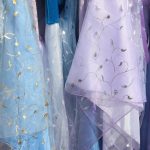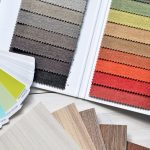Are you often unsure whether the fabric you’re holding is polyester or silk? Don’t worry, we’ve got you covered!
In this article, we will guide you through the process of determining if a fabric is made of polyester or silk.
By understanding the differences in texture, examining the fabric’s sheen, conducting a burn test, checking for static cling, and identifying the fabric’s care instructions, you’ll be able to confidently distinguish between these two commonly used materials.
Table of Contents
Understanding the Differences in Texture
The texture of polyester fabric is smooth, while silk fabric has a more luxurious feel. When it comes to differentiating between natural and synthetic fibers, texture plays a significant role.
Polyester is a synthetic fiber, made from petroleum-based products, while silk is a natural fiber, produced by silkworms. Polyester fabric has a smooth texture due to its synthetic nature. It is often described as being slick and slippery to the touch.
On the other hand, silk fabric has a more luxurious feel. It is known for its softness and smoothness, which is a result of the long, continuous filaments that make up the silk thread. Silk has a natural sheen and a delicate, almost velvety texture.
When comparing the feel of different fabric blends, polyester and silk are at opposite ends of the spectrum. Polyester fabric may feel synthetic and artificial, while silk fabric exudes elegance and sophistication.
Examining the Fabric’s Sheen
To identify the fabric, take a close look at its sheen and feel the texture. When evaluating the fabric’s drape, observe how it falls and hangs. Polyester fabrics tend to have a more stiff and structured drape, while silk fabrics have a more fluid and graceful drape. This is because polyester is a synthetic material, while silk is a natural fiber.
Analyzing the fabric’s weight is another useful method for determining its composition. Polyester fabrics are generally heavier than silk fabrics, as polyester is denser and less breathable. Silk, on the other hand, is lightweight and breathable, making it a popular choice for clothing and accessories.
Additionally, when examining the fabric’s sheen, polyester fabrics often have a high shine and glossy appearance, while silk fabrics have a more subtle and luxurious sheen. By closely examining the fabric’s sheen, evaluating its drape, and analyzing its weight, you can confidently determine whether it is made of polyester or silk.
Conducting a Burn Test
When conducting a burn test, you’ll want to pay attention to the smell and residue left behind. This can help you identify whether the fabric is polyester or silk. Polyester usually has a chemical smell when burned, while silk has a distinct smell similar to burnt hair. The residue left behind also differs between the two fabrics. Polyester leaves behind a hard, plastic-like residue, while silk leaves behind a soft, powdery ash.
Another factor to consider when conducting a burn test is the elasticity of the fabric. Polyester is known for its elasticity, meaning it can stretch and return to its original shape easily. On the other hand, silk is not as elastic and has a natural drape and flow to it.
To summarize the key differences between polyester and silk when conducting a burn test:
| Fabric | Smell | Residue | Elasticity |
|---|---|---|---|
| Polyester | Chemical smell | Hard, plastic-like residue | Elastic |
| Silk | Smell of burnt hair | Soft, powdery ash | Not as elastic |
Checking for Static Cling
Checking for static cling can be done by rubbing a fabric against itself and observing if it generates any static electricity. Static cling occurs when two materials with different levels of electrical charge come into contact, causing them to attract or repel each other. By assessing static cling in fabrics, you can gather valuable information about their composition and properties.
To gain deeper insights into fabric characteristics, consider the following:
-
Measuring fabric density: Density refers to the mass of a fabric per unit volume. Higher density fabrics tend to be heavier and more tightly woven, while lower density fabrics are lighter and may have a looser weave. Density can affect the fabric’s drape, durability, and insulating properties.
-
Observing the fabric’s reaction to moisture: Fabrics can vary in their ability to absorb and release moisture. Natural fibers like silk tend to have good moisture-wicking properties, while synthetic fibers like polyester may repel moisture. By observing how a fabric reacts to moisture, you can determine its breathability and comfort level.
Identifying the Fabric’s Care Instructions
To identify the fabric’s care instructions, you can simply check the labels attached to the clothing items. These labels provide valuable information about how to properly care for your garments. In addition to care instructions, they may also include details about the fabric composition. However, if the labels are missing or illegible, there are other ways to determine the fabric type.
One way to recognize the fabric’s weight is by feeling it. Polyester tends to be lightweight and has a smooth texture, while silk is known for its luxurious and soft feel. By comparing the weight of different fabrics, you can get a sense of whether it is polyester or silk.
Another method is to analyze the fabric’s drape. Polyester is more structured and tends to hold its shape, while silk has a natural flow and drapes beautifully. Hold the fabric up and observe how it falls. Polyester will typically have a stiffer drape, while silk will have a graceful and fluid drape.
Conclusion
In conclusion, by following these steps, you can easily determine whether a fabric is polyester or silk.
Understanding the differences in texture and examining the fabric’s sheen are important factors to consider.
Conducting a burn test can also provide valuable information, as polyester will melt and silk will burn.
Additionally, checking for static cling and identifying the fabric’s care instructions can further help in distinguishing between the two materials.
By being observant and thorough, you can confidently determine the fabric type.
- Tetron Fabric 36: Specifications and Uses - June 17, 2025
- Tetron Fabric Manufacturers in India: Who to Contact - June 17, 2025
- Tetron Fabric Suppliers in Delhi: A Detailed List - June 17, 2025






